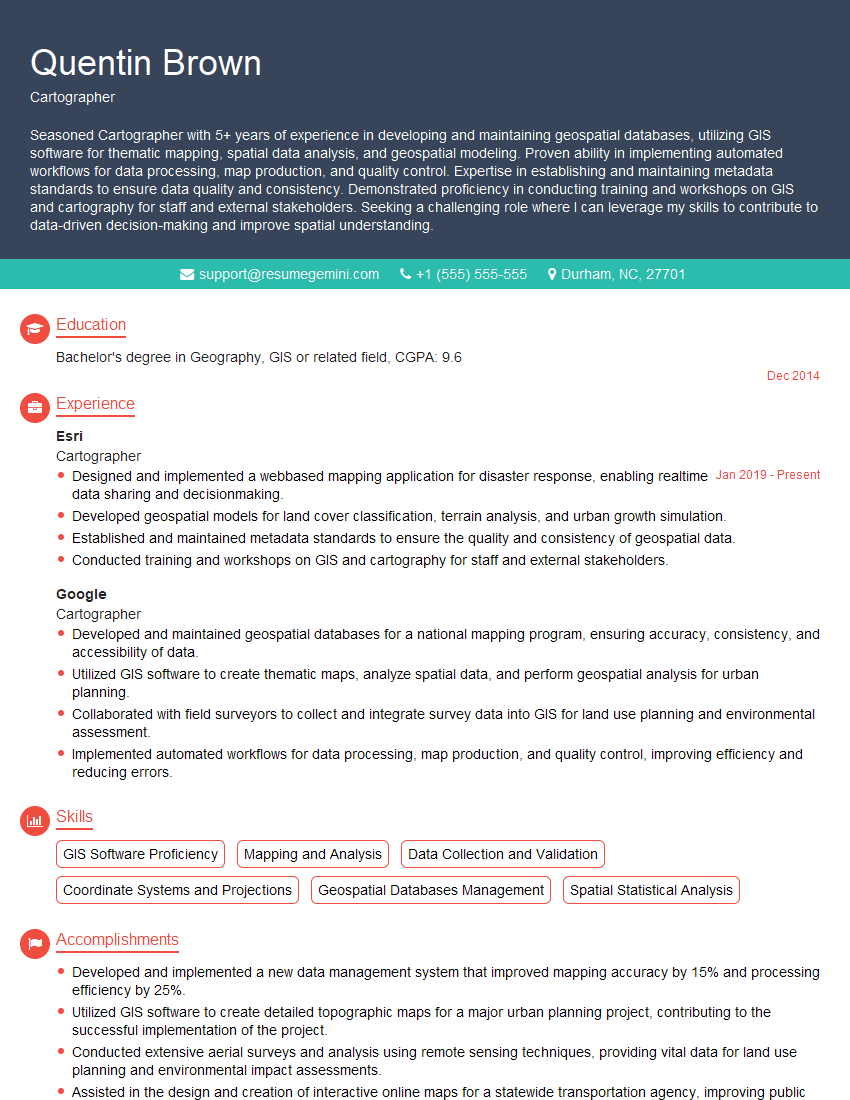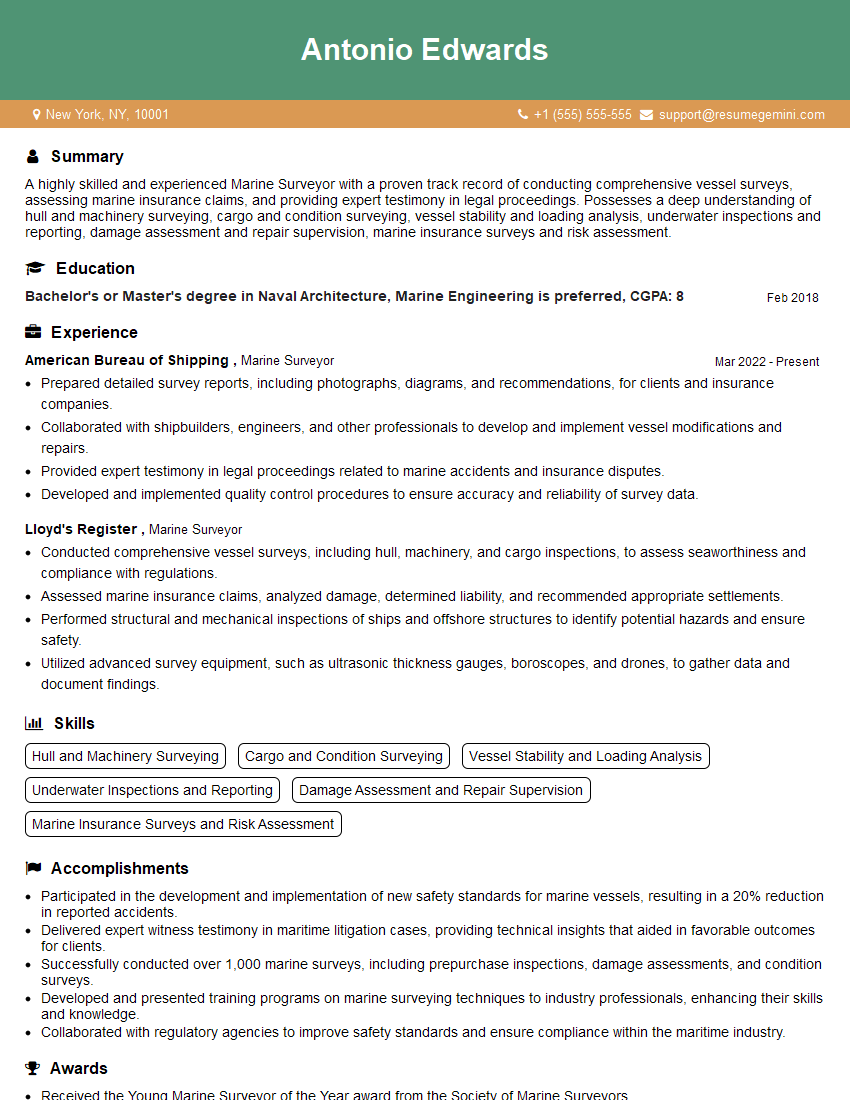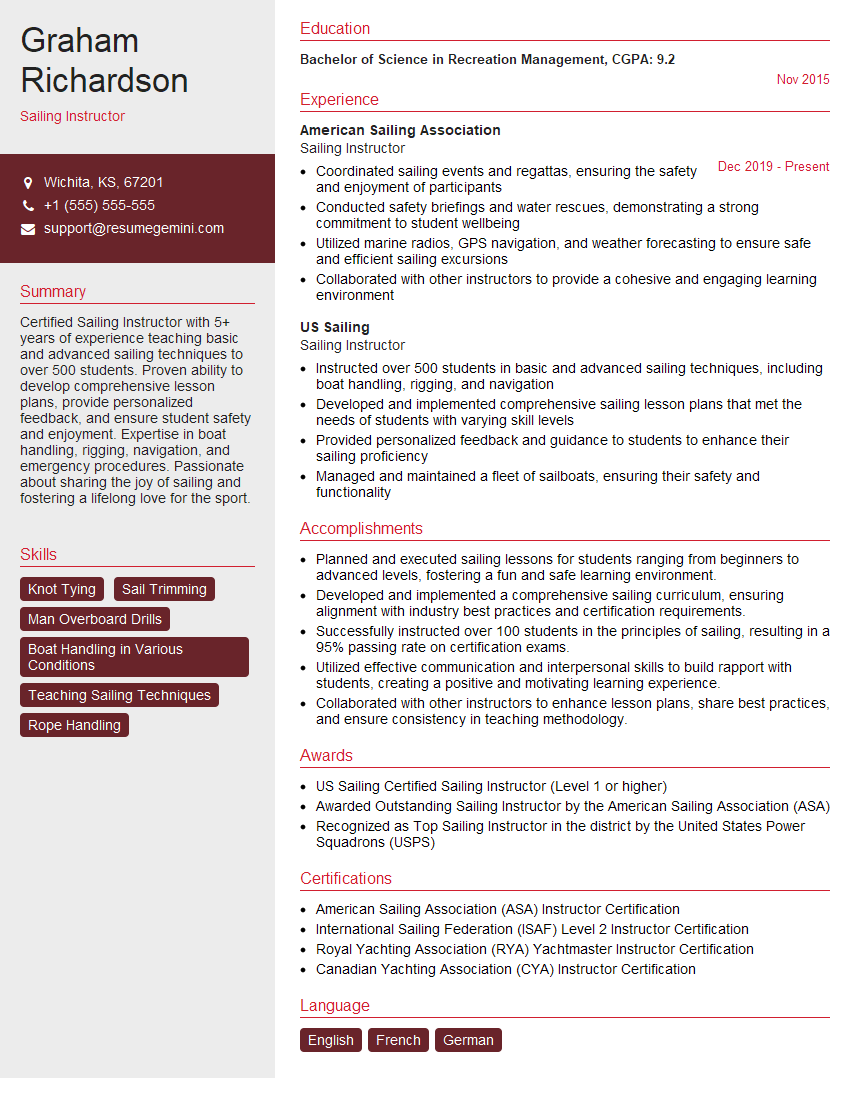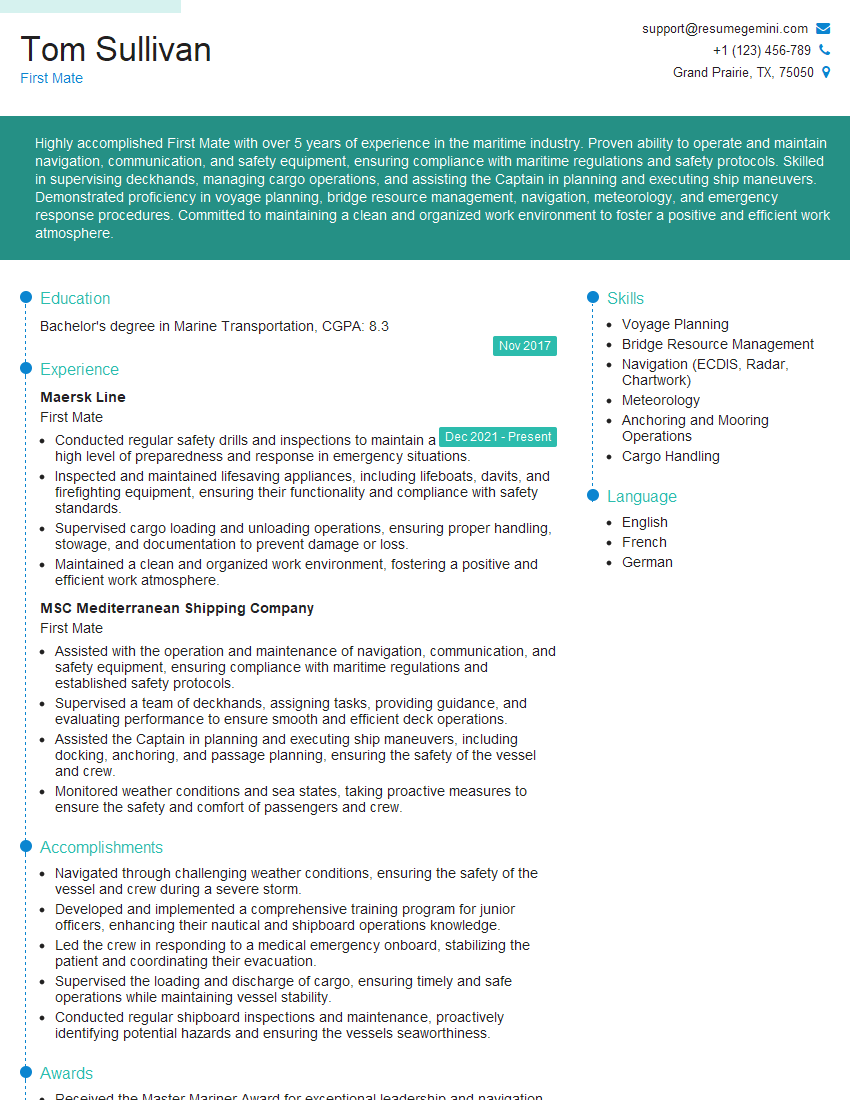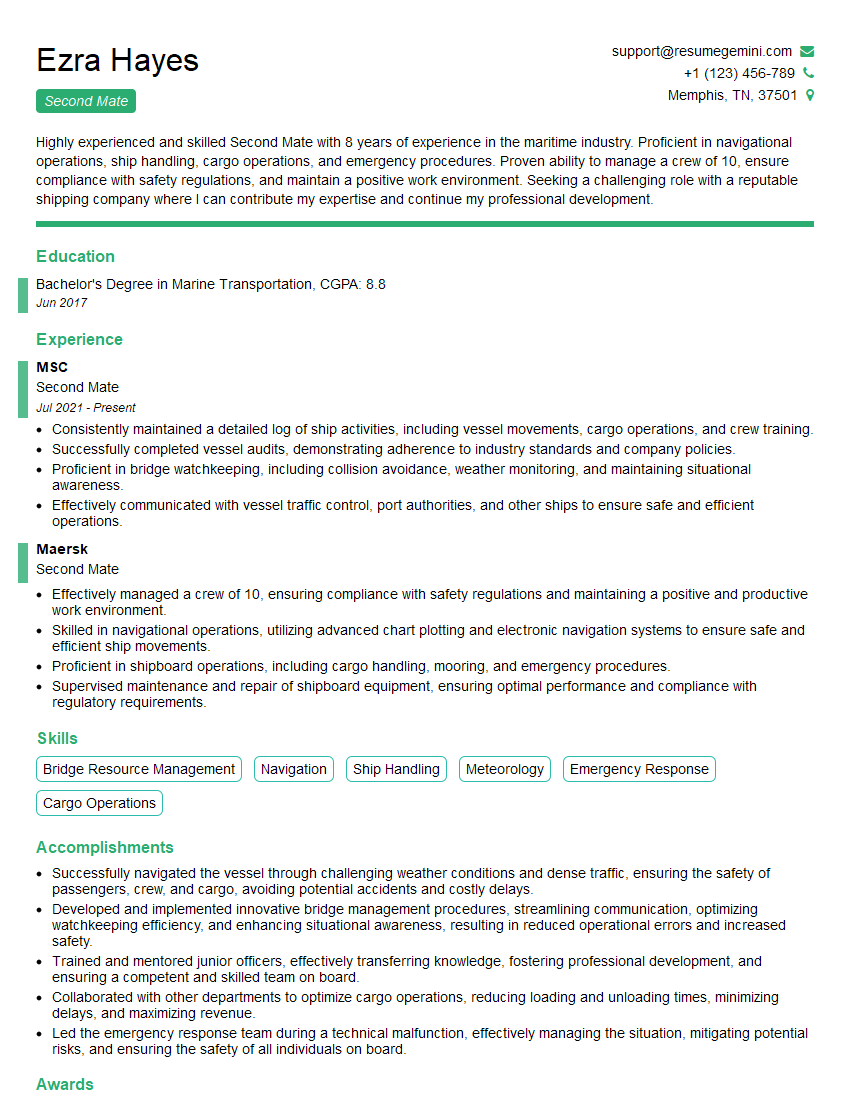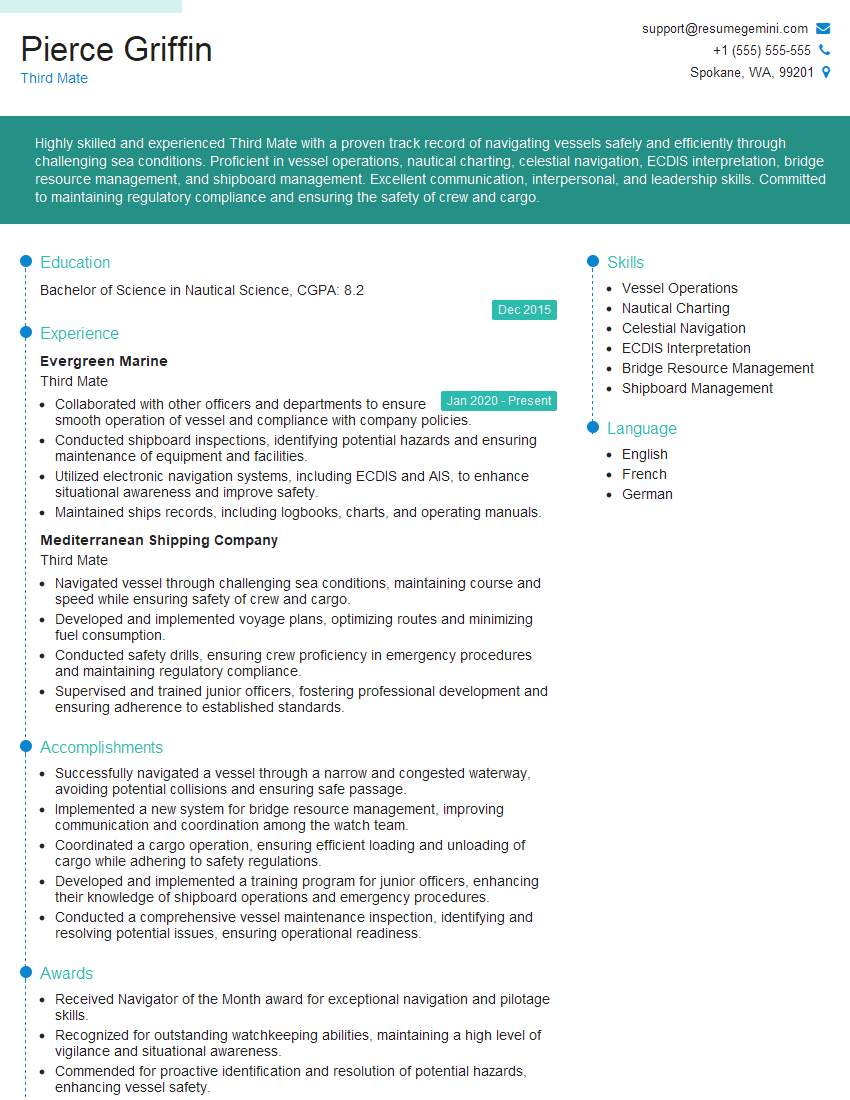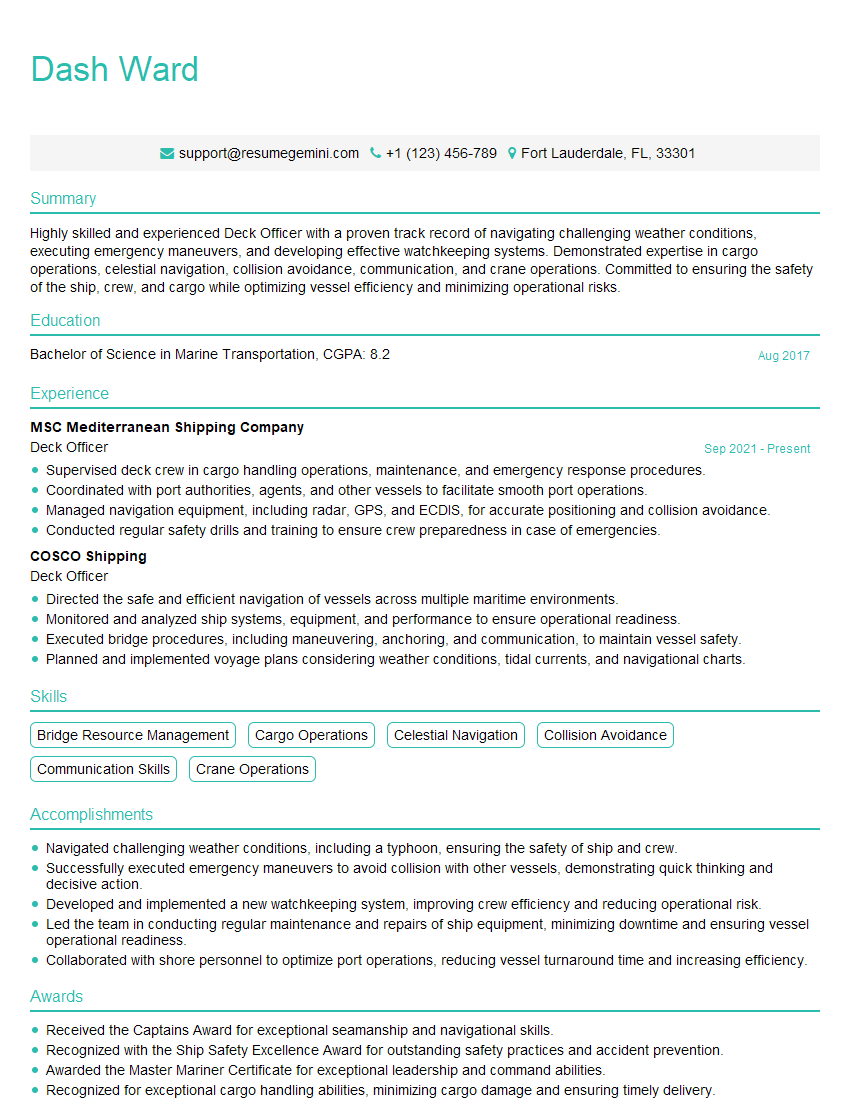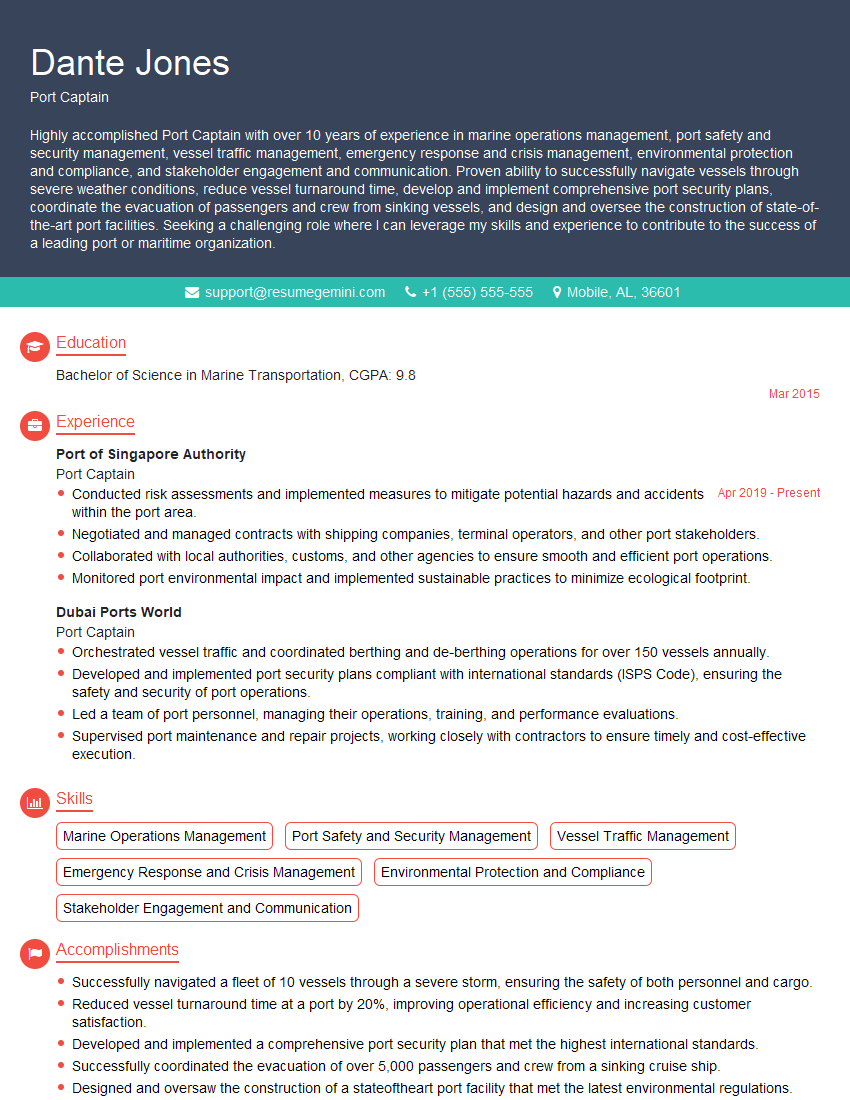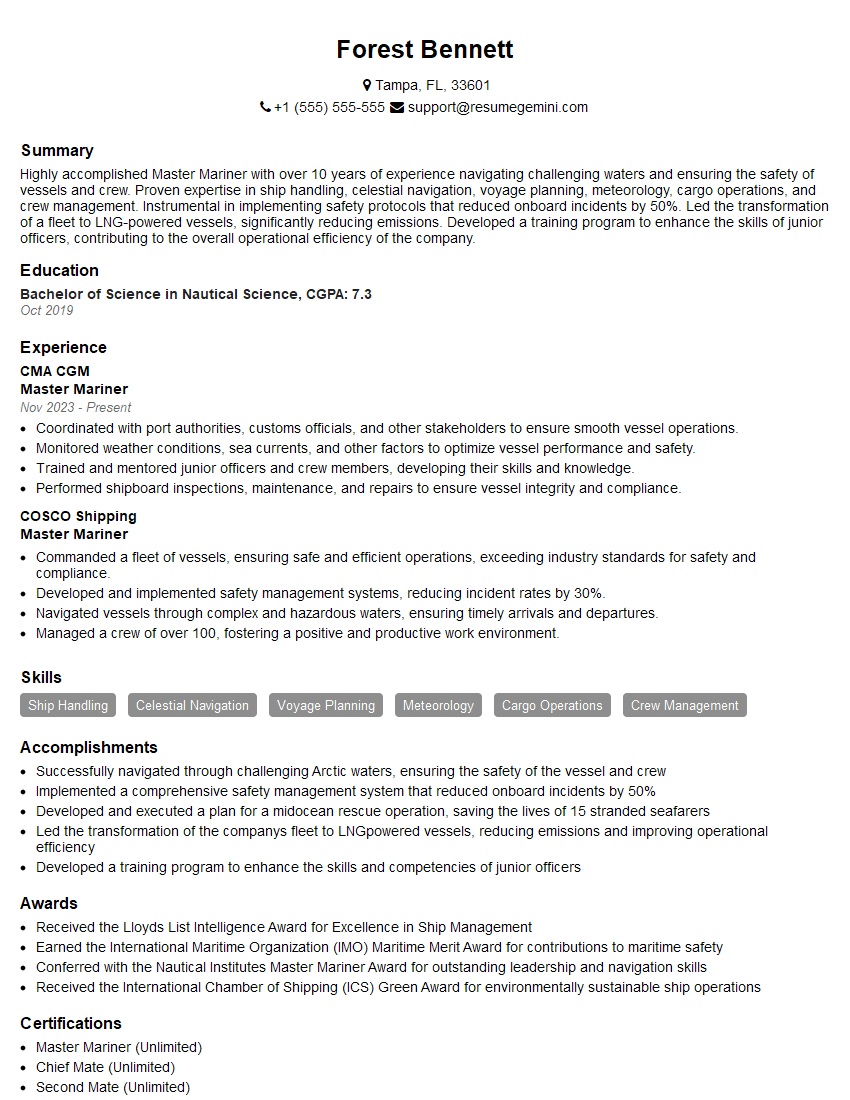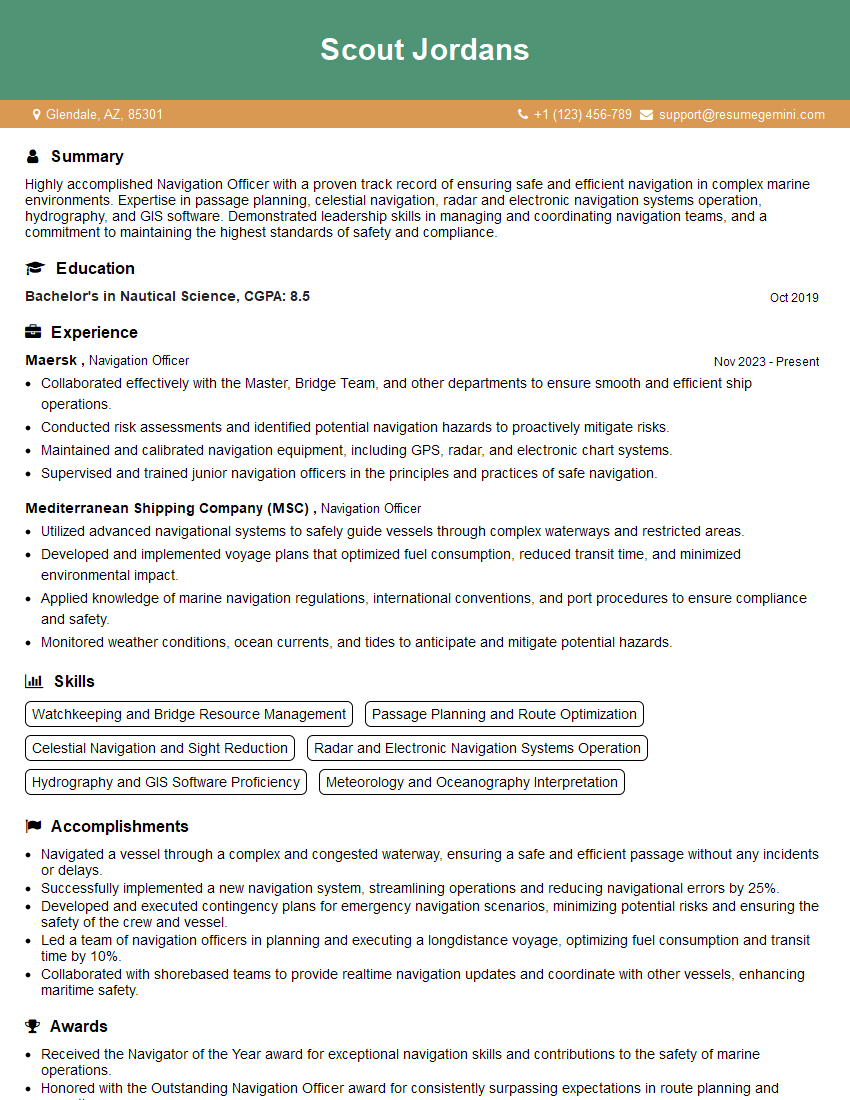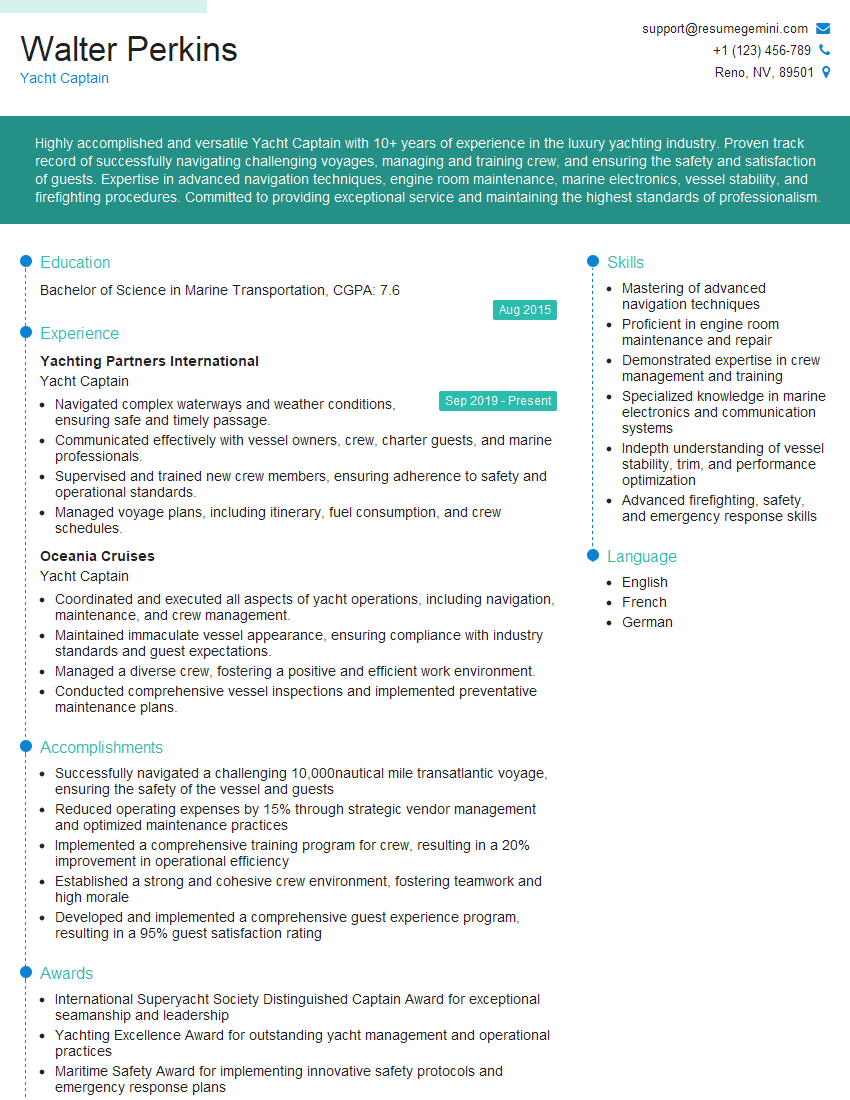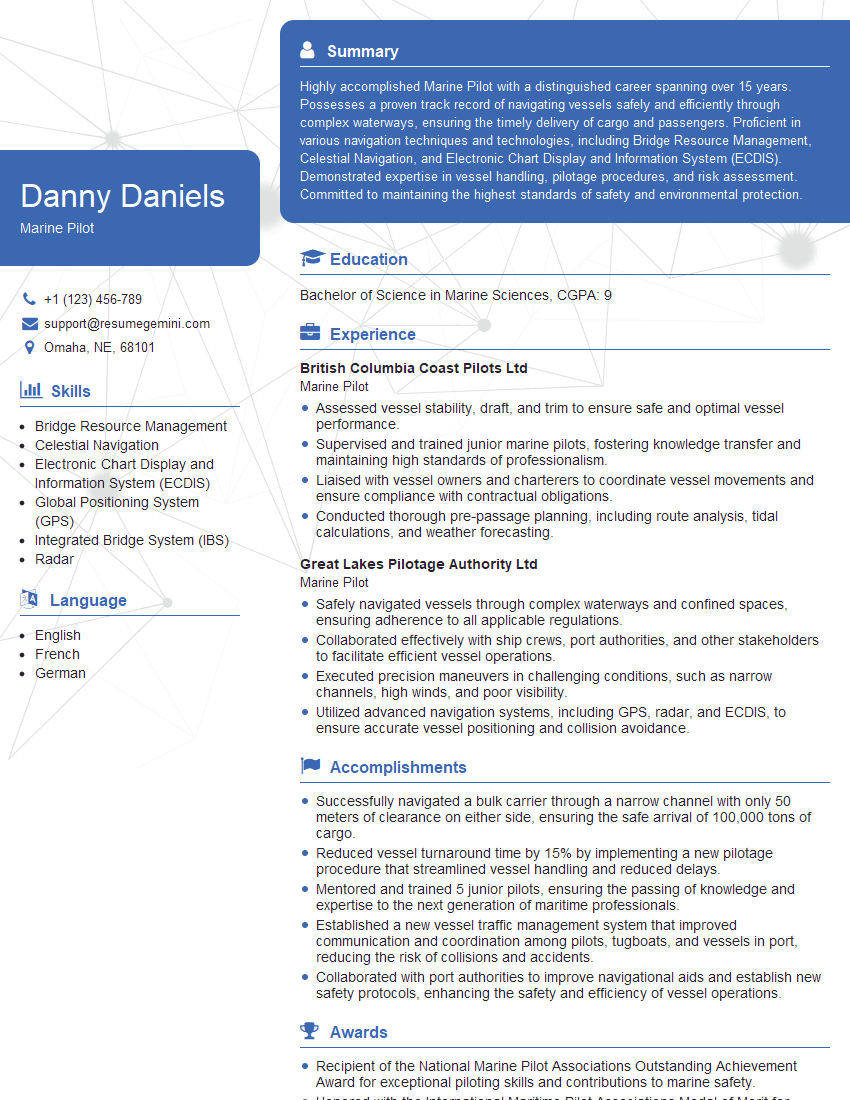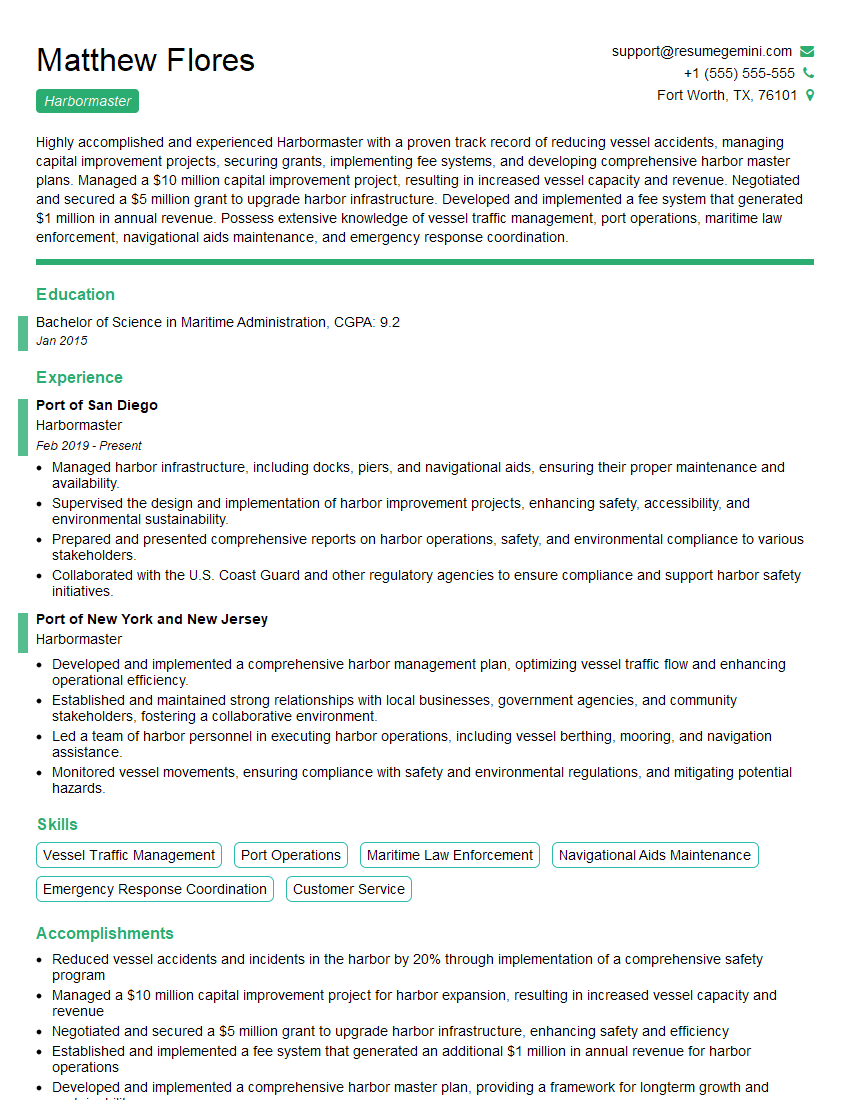Unlock your full potential by mastering the most common Tidal Chart Interpretation interview questions. This blog offers a deep dive into the critical topics, ensuring you’re not only prepared to answer but to excel. With these insights, you’ll approach your interview with clarity and confidence.
Questions Asked in Tidal Chart Interpretation Interview
Q 1. Explain the difference between a standard tidal chart and a harmonic tidal chart.
Standard tidal charts and harmonic tidal charts both predict tide levels, but they differ significantly in their approach. A standard tidal chart presents predicted tide heights (in meters or feet) at specific times for a given location over a period, usually a month or a year. These are presented visually as curves or tables. They are easy to interpret directly but lack flexibility. Imagine a simple graph showing high and low tides for each day. That’s essentially a standard tidal chart.
In contrast, a harmonic tidal chart is based on a mathematical model. It analyzes past tidal data to determine the constituent tidal components (e.g., the semi-diurnal, diurnal, etc.). Instead of directly showing heights and times, it provides the amplitudes and phases of these tidal components. To obtain tide predictions, you need to use a computer program or a specialized tide prediction table, which sums the harmonic components to produce the tide height at any desired time. Think of it as a recipe; the harmonic constants are the ingredients, and the prediction software is the chef, combining these ingredients to create the tidal forecast. This method offers greater accuracy, especially in complex tidal areas, and allows for predictions far into the future or for hypothetical scenarios.
Q 2. How do you interpret tidal ranges and their significance for navigation?
Tidal range refers to the vertical difference between consecutive high and low tide levels. It’s a crucial factor in navigation because it dictates the navigable water depth in shallow areas. A large tidal range means significant changes in water depth during a tidal cycle. For example, a harbor with a large tidal range might be easily accessible at high tide but completely dry at low tide. Conversely, a small tidal range means relatively consistent water depths.
Understanding the tidal range is paramount for safe passage, especially in areas with shallow waters, narrow channels, or submerged obstacles. Before navigating such areas, mariners must carefully check the tidal chart to ensure sufficient water depth throughout their intended route, accounting for the vessel’s draft (the depth of the vessel’s hull below the waterline) and any additional safety margin. A failure to account for the tidal range can result in grounding or other hazardous situations.
For instance, imagine a vessel with a draft of 5 meters attempting to navigate a channel with a minimum charted depth of 6 meters at low tide and a tidal range of 4 meters. At low tide, the available depth is 6 meters. However, at low water, there would only be 1 meter of clearance, which is extremely dangerous. This scenario highlights the critical importance of accurately assessing the tidal range.
Q 3. Describe the various methods for predicting tides.
Tide prediction methods range from simple to sophisticated. The simplest methods rely on historical data, observing past tide patterns to extrapolate future predictions. This is useful for short-term predictions in areas with predictable tides.
More accurate predictions are achieved through harmonic analysis. This method involves decomposing complex tidal patterns into simpler, periodic components (constituents) using Fourier analysis. The amplitudes and phases of these constituents are then used to predict future tides. This offers high accuracy for long-term predictions.
Numerical models are the most sophisticated approach. These models use complex mathematical equations to simulate tidal movements considering factors like coastal geometry, bathymetry (seafloor topography), and astronomical forces. Such models are computationally intensive but provide very accurate and detailed tidal predictions.
Finally, statistical methods, including time series analysis, can be used to refine predictions made using other techniques, offering improved accuracy in some instances.
Q 4. What are the common symbols and abbreviations found on tidal charts?
Tidal charts employ a variety of symbols and abbreviations for clarity. These typically include:
- Abbreviations for tide times and heights: HT (High Tide), LT (Low Tide), HW (High Water), LW (Low Water), followed by the time and height.
- Depth contours: Lines connecting points of equal depth at a given tidal state (e.g., Chart Datum).
- Soundings: Depths of water measured from a reference level (usually Chart Datum) which is typically the lowest astronomical tide.
- Tidal streams (currents): Arrows indicating the direction and speed of tidal currents at specific locations.
- Symbols for navigational hazards: Rocks, wrecks, etc., crucial information alongside tidal information to help safe navigation.
- Abbreviations for tidal constituents: In harmonic tidal charts, abbreviations like M2 (principal lunar semi-diurnal constituent) and S2 (principal solar semi-diurnal constituent) are used to represent different harmonic components.
Understanding these symbols and abbreviations is essential for accurate chart interpretation. Each chart will typically include a legend explaining its specific symbols and conventions.
Q 5. How do you use tidal data to plan a safe passage?
Using tidal data for safe passage involves a methodical approach:
- Determine the route: Identify the intended course, taking into account navigational hazards and water depths.
- Consult the tidal chart: Find the relevant chart covering the planned route. Note the tidal range, predicted tide heights and times for relevant locations along the route.
- Calculate minimum depths: Subtract the vessel’s draft from the charted depths at the lowest tide expected during passage.
- Check for sufficient clearance: Ensure sufficient under-keel clearance (the vertical distance between the vessel’s keel and the seabed) at all points along the route, allowing for a safety margin. A general rule is to maintain several meters of additional clearance, but this is dependent on vessel type, weather conditions, and the nature of the seabed.
- Time the passage: Plan the journey to coincide with favorable tidal conditions. This might involve selecting specific times to transit narrow channels or shallow areas.
- Monitor tidal conditions: Be aware of changing tidal conditions during the voyage. Use onboard instruments or receive updates to verify that the planned route remains safe and adjust the plan accordingly.
This detailed approach ensures that navigators can adjust their routes based on the current tides and always maintain an appropriate safety margin.
Q 6. Explain the concept of tidal currents and their impact on navigation.
Tidal currents are the horizontal movements of water caused by the rise and fall of tides. They can be strong and unpredictable, especially in narrow channels, estuaries, and coastal areas with complex bathymetry. They are unlike ocean currents which are driven by factors such as wind, temperature differences, and the earth’s rotation. Tidal currents typically follow a predictable pattern, reversing their direction with the change of tides.
Tidal currents significantly impact navigation by influencing vessel speed and direction. A strong current flowing in the same direction as the vessel will increase its speed over ground; a current flowing against the vessel will decrease its speed. A strong current flowing perpendicular to the vessel’s course will cause the vessel to drift laterally, requiring corrections in steering. In extreme situations, currents can be too strong for a vessel to navigate, even with optimal power.
Mariners must consult tidal current atlases or charts to predict current strength and direction along their routes. This is particularly crucial when navigating narrow channels or areas with complex currents, to ensure that the vessel can maneuver safely and prevent being pushed onto hazards. Failing to properly account for tidal currents can lead to delays, increased fuel consumption, and potential navigational hazards.
Q 7. How do you account for tidal effects when calculating vessel speed and ETA?
Tidal effects must be incorporated into vessel speed and ETA (Estimated Time of Arrival) calculations. The speed of a vessel over ground is not just its speed through the water. The current adds or subtracts from its velocity, influencing its actual progress.
To account for tidal effects:
- Determine the current velocity and direction: Consult tidal current atlases or charts to find the predicted current speed and direction for the relevant location and time.
- Resolve vectors: Resolve the vessel’s speed through water (determined by speed logs or GPS) and the current velocity into components in the same direction (longitudinal) and perpendicular direction (transverse).
- Calculate speed over ground: Add the longitudinal components (vector addition). The magnitude of the resultant vector is the vessel’s speed over ground. The transverse component results in a drift or crab effect needing to be factored in for course correction.
- Calculate ETA: Use the speed over ground, considering the longitudinal component of the current, to estimate the time it will take to reach the destination. Consider that adverse currents will lengthen journey time and favourable currents will shorten it.
Failing to adjust for tidal currents will lead to inaccurate ETA calculations and potentially significant delays or even missing a tidal window for safe passage through shallow waters.
Q 8. Describe the process of identifying a specific location using tidal chart information.
Identifying a specific location on a tidal chart involves a multi-step process. First, you need to understand the chart’s projection and scale. Tidal charts, like nautical charts, use a specific map projection to represent the Earth’s curved surface on a flat plane. The scale indicates the relationship between distances on the chart and actual distances on the water. Second, you’ll locate your position using latitude and longitude coordinates, or by referencing prominent landmarks depicted on the chart. These landmarks might include lighthouses, buoys, or prominent geographical features. Once you’ve pinpointed your location, you can then examine the surrounding area for relevant tidal information, such as depth contours and tidal ranges.
For instance, imagine you’re planning a boat trip near a specific island. You’d first use the chart’s latitude and longitude grid to find the island’s position. Then, you would carefully study the surrounding depths indicated by the contour lines to identify safe navigation channels and areas to avoid at low tide. The combination of your location and the depth contours allows you to accurately assess the water’s depth at a specific time and location, keeping your navigation safe.
Q 9. How do you interpret and use tidal stream atlases?
Tidal stream atlases are invaluable tools for mariners, providing information about the speed and direction of tidal currents. Interpreting these atlases requires understanding their format, which typically presents tidal current information using arrows and numbers. Arrows show the direction of the current, and numbers represent the speed, usually in knots. These atlases often include charts showing current patterns at various stages of the tide, typically presented as a series of charts or diagrams for different times and tidal states (e.g., high slack water, maximum ebb, etc.).
To use a tidal stream atlas effectively, you first determine your location on the chart. Then, you identify the specific time of your planned transit. Using the information provided for that location and time, you can determine the expected current’s speed and direction. This knowledge is crucial for safe navigation, as strong tidal currents can significantly impact a vessel’s speed and course, potentially delaying arrival times or creating dangerous situations in confined waters. For example, navigating a narrow channel during a strong tidal current could cause you to lose steering control or experience a hazardous reduction in your vessel’s speed. Always factor in the current to your overall navigation plan.
Q 10. Explain the influence of lunar cycles on tidal patterns.
The gravitational pull of the moon is the primary driver of tides. The moon’s position relative to the Earth significantly influences the tidal pattern. The sun also plays a role, though to a lesser extent. During a new moon or full moon (syzygy), the sun, Earth, and moon align, resulting in a combined gravitational pull, creating higher high tides and lower low tides—these are called spring tides. Conversely, during the first and third quarter moons (quadrature), the sun and moon are at right angles to each other, resulting in a reduced gravitational pull, leading to smaller tidal ranges—these are neap tides.
Imagine the Earth and moon as two bowling balls: When they’re aligned (spring tide), their combined pull creates a stronger ‘tug’ on the water. When they’re at an angle (neap tide), the pulls partially cancel each other out, creating a weaker ‘tug’. This difference in gravitational pull directly impacts the height and frequency of tides, resulting in a noticeable variation throughout the lunar cycle. This knowledge is essential for planning activities that are highly sensitive to tidal fluctuations, such as beach landings or navigating shallow-draft vessels.
Q 11. How do you determine the height of the tide at a given time and location?
Determining the height of the tide at a specific time and location requires using the tidal predictions found within the tidal chart or a separate tidal prediction table. These predictions are usually presented as a tide table, listing high and low water times and heights for specific locations. These tables are derived from complex harmonic analysis of past tidal data. To find the height, you first locate your position on the chart. Next, locate the corresponding tidal prediction information for that location in the accompanying tables.
For example, if the tidal prediction table shows a high tide of 5 meters at 2:00 PM, and you are at that location at 2:00 PM, the tide height will be 5 meters. However, to find the tide height at other times, you may need to use tidal curves or interpolation. Many charts provide curves that graphically show the tidal changes over time, allowing you to estimate the tide’s height at any time within a tidal cycle. If precise accuracy is crucial, consult a more advanced tidal prediction system.
Q 12. What are the potential dangers associated with misinterpreting tidal information?
Misinterpreting tidal information can lead to serious consequences, particularly for mariners and those involved in coastal activities. Mistakes can range from minor inconveniences to life-threatening situations. Underestimating the tidal range can cause a vessel to run aground, while misjudging the current’s speed can lead to collisions or difficulties in maneuvering. Incorrectly predicting the timing of high or low tide can lead to being trapped in a shallow area or unable to access a desired location.
Imagine a situation where a vessel misjudges the tide’s height and enters a channel that’s too shallow at low tide. The result could be grounding, causing damage to the vessel and potentially endangering its crew. Or, consider a situation where a boat forgets to account for a strong tidal current when entering a narrow harbor. This could lead to a collision with another vessel, or they may not be able to make their planned passage safely. This highlights the critical importance of careful planning and accurate interpretation of tidal data.
Q 13. How do you identify and understand tidal datum levels on a chart?
Tidal datum levels on a chart represent a reference point for measuring water depths. The most commonly used datum is Chart Datum (CD), which is a low water level that is chosen to be lower than any predicted low tide. Other datums, such as Mean Low Water (MLW) or Mean Lower Low Water (MLLW), are also used, and their definitions depend on the specific region and the local tidal patterns. These datums are essential for accurately depicting depths on the chart. Depth soundings, or the numerical values indicating water depths printed on charts, are relative to the chart datum stated on the chart.
For example, if a chart uses Mean Low Water (MLW) as its datum and a sounding shows ‘6 meters,’ it signifies that the depth is 6 meters below the average low water level. Therefore, understanding the chart’s datum is crucial to calculating the actual water depth at a particular time, as the water level will fluctuate throughout the tidal cycle. Always check the chart’s legend to determine the datum used before interpreting any depths.
Q 14. Explain the impact of spring and neap tides on navigation.
Spring and neap tides significantly impact navigation due to their contrasting tidal ranges. Spring tides, with their higher high waters and lower low waters, result in greater depth variations, making navigation in shallow areas more challenging or even impossible during low tide. Conversely, neap tides, with smaller tidal ranges, offer more consistent depths, potentially making navigation easier but still requiring careful attention to depth restrictions. The increased current speeds associated with spring tides also pose challenges to navigation, requiring careful planning and potentially impacting fuel efficiency.
In practice, navigating during spring tides means being more cautious about shallow areas. A channel that might be navigable at high tide during neap tides might become impassable at low tide during spring tides. Additionally, the strong currents during spring tides require more precise boat handling and increased allowance for time. Understanding the impact of these tidal variations is crucial for developing safe and efficient navigation strategies.
Q 15. How do you account for changes in water depth due to tides?
Accounting for tidal changes in water depth is fundamental to safe navigation. Tidal charts depict depths relative to a specific chart datum (usually Mean Lower Low Water or similar), but the actual water depth at any given time varies with the tide. To determine the actual depth, you must add (or subtract) the predicted tidal height from the chart depth. For example, if a chart shows a depth of 10 meters at a particular location and the tide table indicates a predicted height of 2 meters above chart datum, the actual depth at that moment will be 12 meters. Conversely, if the tide is below the chart datum, you would subtract the difference.
Imagine you’re fishing. Your chart shows 5 meters at your spot. However, the tide table shows the water is currently 1 meter *below* the chart datum. This means you only have 4 meters of water under your boat, necessitating caution.
Career Expert Tips:
- Ace those interviews! Prepare effectively by reviewing the Top 50 Most Common Interview Questions on ResumeGemini.
- Navigate your job search with confidence! Explore a wide range of Career Tips on ResumeGemini. Learn about common challenges and recommendations to overcome them.
- Craft the perfect resume! Master the Art of Resume Writing with ResumeGemini’s guide. Showcase your unique qualifications and achievements effectively.
- Don’t miss out on holiday savings! Build your dream resume with ResumeGemini’s ATS optimized templates.
Q 16. Describe the process of calculating the time of high and low water at a specific location.
Calculating the time of high and low water for a specific location involves utilizing tidal prediction models and tide tables. These tables are generated using complex harmonic analysis of historical tide gauge data. The process typically involves:
- Locating the desired location on a tide table or using a tidal prediction software. The tables are usually organized by geographical location and provide predicted times and heights of high and low water for each day.
- Identifying the appropriate time zone. Tidal predictions are always given for a specific time zone.
- Interpreting the data. The table will show the predicted time and height of high (HW) and low (LW) waters. For instance, ‘HW 10:30 3.5m’ means high water at 10:30 with a height of 3.5 meters above the chart datum.
In areas with complex tidal patterns, specialized software might be needed to accurately predict times of high and low water. This software uses sophisticated algorithms considering astronomical factors and local geographical influences.
Q 17. What are the limitations of tidal prediction models?
Tidal prediction models, while sophisticated, have limitations. Accuracy is affected by several factors:
- Meteorological influences: Strong winds and atmospheric pressure changes can significantly alter predicted tidal heights and times. A sudden storm, for instance, can cause higher than predicted high tides or lower low tides.
- Model complexity: Simplified models might not accurately capture the nuances of complex coastal geographies, leading to prediction errors, especially in areas with intricate coastlines or strong currents.
- Data limitations: The accuracy of the prediction depends on the quality and length of the historical tide gauge data used to calibrate the model. Sparse or unreliable data can result in less accurate predictions.
- Long-term predictions: Predictions made far in advance are generally less accurate than those made closer to the event due to accumulated uncertainties.
It is important to always consider these limitations and exercise caution when relying solely on predicted tidal information, especially in challenging navigational circumstances.
Q 18. How do you use a tide table in conjunction with a tidal chart?
Tide tables and tidal charts work in tandem to provide a comprehensive understanding of tidal conditions. The tidal chart shows depths and contours relative to a specific chart datum, while the tide table provides the predicted height of the tide above that datum at specific times.
For example, suppose your chart shows a depth of 6 meters at a particular point, and your tide table shows a high water height of 3 meters at 2 PM. This means that at 2 PM, the actual depth at that point would be 9 meters (6 meters + 3 meters). However, if the tide table shows a low water height of -1 meter at 8 AM (meaning 1 meter below the chart datum), the actual depth would only be 5 meters at that time.
Essentially, the tide table tells you *how much* to add or subtract to the charted depth to obtain the actual depth at a specific time.
Q 19. Explain how to correct for tidal currents when plotting a course.
Correcting for tidal currents when plotting a course is vital for safe and efficient navigation. Tidal currents can significantly affect a vessel’s track and speed. The process involves:
- Obtaining tidal current information: This can be found on tidal current charts or in specialized tidal current atlases. These charts show the predicted direction and speed of the current at various locations.
- Determining the current’s effect on your vessel: The current’s speed and direction will affect your vessel’s course and speed; a strong current against your heading will slow you down, whereas a current assisting you will speed you up.
- Correcting your course and speed: To counteract the current, you need to adjust your heading to compensate for its effect. Vectorial calculations or specialized navigational tools are used to find the necessary course correction. You also need to factor in the current’s impact on your overall speed.
For instance, imagine you’re sailing due North, and a strong westerly current is pushing your boat eastward at 2 knots. You need to adjust your heading slightly to the west of North to counteract this eastward drift. This calculation is crucial to accurately predict your position and arrive at your desired destination on time.
Q 20. Describe various types of tidal patterns (e.g., diurnal, semi-diurnal, mixed).
Tidal patterns vary based on geographical location and the interaction of astronomical forces. There are three main types:
- Diurnal Tides: One high tide and one low tide per day. These are relatively uncommon but occur in certain areas of the world.
- Semi-diurnal Tides: Two high tides and two low tides approximately equal in height and spaced about 12 hours apart. This is the most common tidal pattern in many parts of the world.
- Mixed Tides: A combination of diurnal and semi-diurnal tides. These have two high tides and two low tides per day, but the heights of the high and low tides are unequal, and the times between high and low tides are not consistent.
Imagine a beach with semi-diurnal tides. You can expect roughly two high tides and two low tides every day, with relatively consistent time intervals. In contrast, a mixed tide area might have a big difference in height between the two high tides, making planning activities at low tide much more critical.
Q 21. How do you use tidal information to determine safe underwater clearance?
Determining safe underwater clearance requires combining depth information from the chart with tidal predictions from a tide table.
First, identify the minimum depth required for your vessel (draft). This is usually found in your vessel’s documentation. Next, consult the chart to find the charted depth at your intended location. Finally, check the tide table for the predicted water height at that time. Subtract the vessel’s draft from the sum of the charted depth and the predicted tidal height. The result is your actual underwater clearance. If this value is insufficient, you either need to change your time of passage, alter your route, or postpone your trip until sufficient depth is available.
For example, suppose your vessel has a draft of 2 meters. The chart shows a depth of 7 meters, and the tide table shows the water level at that moment is 1 meter above the chart datum. Your underwater clearance would be: (7 meters + 1 meter) – 2 meters = 6 meters. If your required underwater clearance is 4 meters, you have 2 meters of leeway and thus would be able to proceed safely.
Q 22. What are the sources of tidal chart data?
Tidal chart data originates from a combination of sources, primarily focusing on precise measurements and sophisticated modeling. The most fundamental source is tidal gauge data. These gauges, strategically located along coastlines, continuously record water level changes over time. This raw data provides the basis for understanding local tidal patterns.
Harmonic analysis is then applied to this raw data. This complex mathematical process decomposes the observed tidal fluctuations into constituent waves, each with a specific period and amplitude. This allows us to predict future tides with remarkable accuracy, even accounting for the complex interplay of various astronomical forces.
Furthermore, numerical hydrodynamic models use sophisticated computational techniques to simulate water movement within an entire coastal region. These models incorporate various factors like bathymetry (seafloor topography), coastal geometry, and astronomical forcing to create highly detailed and accurate tidal predictions across broader areas.
Finally, data from satellite altimetry is becoming increasingly important. Satellites equipped with radar altimeters can measure sea surface height across vast ocean expanses, providing valuable data for refining and validating both tidal gauge measurements and hydrodynamic models.
Q 23. Explain the concept of chart datum and its importance in navigation.
Chart datum is a fundamental reference level used on nautical charts. It’s the lowest astronomical tide (LAT) – the lowest tide predicted to occur based on a long period of tidal observations. Think of it as the baseline from which all other water depths are measured.
Its importance in navigation is paramount. Knowing the chart datum allows navigators to confidently determine the available water depth under their vessel at any given time. If a chart indicates a depth of 10 meters and the tide is 3 meters above chart datum, a vessel with a draft of 8 meters can safely navigate that area. Without a standardized reference point like chart datum, safe navigation would be impossible.
Using a different reference level could lead to disastrous consequences. For instance, relying on mean low water (MLW) instead of LAT in a region with significant tidal variations could result in vessels running aground, even with seemingly sufficient clearance based on the incorrect reference.
Q 24. How do you identify and interpret tidal information presented in a different format (e.g., digital tide gauge data)?
Interpreting tidal information from diverse sources like digital tide gauge data requires careful attention to the data format and units. First, understand the data structure. Is the data presented as hourly readings, a series of predicted values, or a combination? What are the units (meters, feet)? The metadata accompanying the data usually provides this information.
Next, identify the reference level. Ensure you know whether the data is relative to chart datum, mean sea level, or another reference. This is crucial for converting the data to depths relative to the chart datum used in your nautical charts.
Then, analyze the data trend. Look for the high and low tide points, and calculate the tidal range. You might use spreadsheet software or programming languages like Python with libraries such as Pandas and Matplotlib to visualize the data and identify these key points. This visual representation makes it easier to understand tidal patterns.
Example: If digital tide gauge data shows a water level of 5 meters above mean sea level (MSL) and the chart datum is 1 meter below MSL, then the actual water depth above chart datum is 6 meters (5 + 1).
Q 25. What software or tools do you use for tidal chart interpretation?
A variety of software and tools are used for tidal chart interpretation. Many professional navigators rely on specialized Electronic Chart Display and Information Systems (ECDIS). These systems integrate real-time GPS data with electronic nautical charts and incorporate tidal prediction models to provide dynamic displays showing available water depths.
Stand-alone tidal prediction software packages offer detailed tidal predictions for specific locations based on various harmonic constants and other astronomical inputs. These packages often include features for generating tidal curves, predicting current strengths and directions, and exporting data in various formats.
Spreadsheet software like Microsoft Excel or Google Sheets can be used for basic analysis of tidal data. They allow for simple calculations and visualizations, which can be helpful for a preliminary understanding of tidal patterns. Finally, navigation apps and websites, such as those provided by NOAA or similar organizations, often have interactive tidal prediction tools.
Q 26. Describe a situation where you had to make a critical decision based on tidal information. (Focus on the process and technical aspects, not emotions).
During a recent coastal survey, we needed to determine the optimal timing for deploying an underwater remotely operated vehicle (ROV). The ROV was designed to operate at a minimal depth of 5 meters. Our survey area had significant tidal fluctuations.
Using tidal prediction software based on the local harmonic constants, I generated a tidal curve for the relevant period. I analyzed the curve to identify the time window where the depth consistently remained above the 5-meter threshold, accounting for a margin of safety due to potential inaccuracies in the prediction. This analysis determined the safe operational window for the ROV deployment, ensuring the mission’s success.
The process involved comparing the predicted tidal heights with the charted depths to calculate the available water depth at various times. This careful calculation, factoring in both tidal variations and the ROV’s minimum operational depth, avoided potential equipment damage or mission failure.
Q 27. Explain the difference between a tidal range and a tidal current.
Tidal range and tidal current are closely related but distinct aspects of the tide. Tidal range refers to the vertical difference between the high and low water levels during a tidal cycle. It represents the total rise and fall of the sea level.
Tidal current, on the other hand, is the horizontal movement of water caused by the rise and fall of the tide. This movement can be significant, especially in constricted waterways like channels and inlets. While tidal range describes the vertical change, tidal current describes the horizontal flow, both being driven by the same astronomical forces.
Example: A tidal range of 4 meters indicates that the sea level rises and falls by 4 meters during a tidal cycle. Simultaneously, the tidal current may flow at 2 knots during the flood tide (rising tide) and 1.5 knots during the ebb tide (falling tide) in a particular channel.
Q 28. How would you explain tidal phenomena to someone without a nautical background?
Imagine a giant bathtub, the ocean, and two huge invisible hands, the moon and the sun. These hands gently pull and push on the water, creating bulges (high tides) and dips (low tides). The moon’s pull is stronger, so it primarily drives the tides.
As the Earth rotates, different areas of the bathtub (ocean) pass under these bulges and dips, causing the sea level to rise and fall. This rise and fall is what we experience as high and low tide. The time between high and low tides varies depending on the location and the interaction between the sun and the moon’s gravitational pull.
Think of it like a slow wave traveling around the Earth, causing the water to rise and fall along the coastlines. The shape of the coastline, seafloor, and other factors influence exactly how high and how fast the water moves in a given area.
Key Topics to Learn for Tidal Chart Interpretation Interview
- Understanding Tidal Datums: Learn the different types of tidal datums (e.g., Mean Lower Low Water, Chart Datum) and their significance in navigation and chart reading.
- Interpreting Tidal Curves and Predictions: Practice reading tidal curves to predict high and low water times and heights at specific locations. Understand the impact of tidal currents.
- Working with Tidal Ranges and Differences: Calculate tidal ranges and differences to understand the extent of tidal influence in a given area. Apply this knowledge to safe navigation practices.
- Identifying and Using Tidal Information on Charts: Become proficient in locating and interpreting tidal information presented on nautical charts, including tidal diamonds and explanatory notes.
- Applying Tidal Information to Navigation Planning: Practice planning a voyage incorporating tidal information, considering factors such as depth, currents, and timing of tides for safe passage.
- Understanding the Effects of Tides on Navigation: Analyze how tides affect vessel draft, maneuvering, and overall safety, considering factors like restricted waters and shallow areas.
- Troubleshooting and Problem Solving: Develop your ability to analyze real-world scenarios involving tidal challenges and formulate effective solutions. This could involve understanding discrepancies between predicted and observed tides.
Next Steps
Mastering Tidal Chart Interpretation is crucial for career advancement in maritime professions, significantly enhancing your safety awareness and operational efficiency. To maximize your job prospects, create a compelling and ATS-friendly resume that highlights your skills and experience effectively. ResumeGemini is a trusted resource to help you build a professional and impactful resume. We provide examples of resumes tailored specifically to Tidal Chart Interpretation to guide you through the process.
Explore more articles
Users Rating of Our Blogs
Share Your Experience
We value your feedback! Please rate our content and share your thoughts (optional).
What Readers Say About Our Blog
Hello,
We found issues with your domain’s email setup that may be sending your messages to spam or blocking them completely. InboxShield Mini shows you how to fix it in minutes — no tech skills required.
Scan your domain now for details: https://inboxshield-mini.com/
— Adam @ InboxShield Mini
Reply STOP to unsubscribe
Hi, are you owner of interviewgemini.com? What if I told you I could help you find extra time in your schedule, reconnect with leads you didn’t even realize you missed, and bring in more “I want to work with you” conversations, without increasing your ad spend or hiring a full-time employee?
All with a flexible, budget-friendly service that could easily pay for itself. Sounds good?
Would it be nice to jump on a quick 10-minute call so I can show you exactly how we make this work?
Best,
Hapei
Marketing Director
Hey, I know you’re the owner of interviewgemini.com. I’ll be quick.
Fundraising for your business is tough and time-consuming. We make it easier by guaranteeing two private investor meetings each month, for six months. No demos, no pitch events – just direct introductions to active investors matched to your startup.
If youR17;re raising, this could help you build real momentum. Want me to send more info?
Hi, I represent an SEO company that specialises in getting you AI citations and higher rankings on Google. I’d like to offer you a 100% free SEO audit for your website. Would you be interested?
Hi, I represent an SEO company that specialises in getting you AI citations and higher rankings on Google. I’d like to offer you a 100% free SEO audit for your website. Would you be interested?
good
